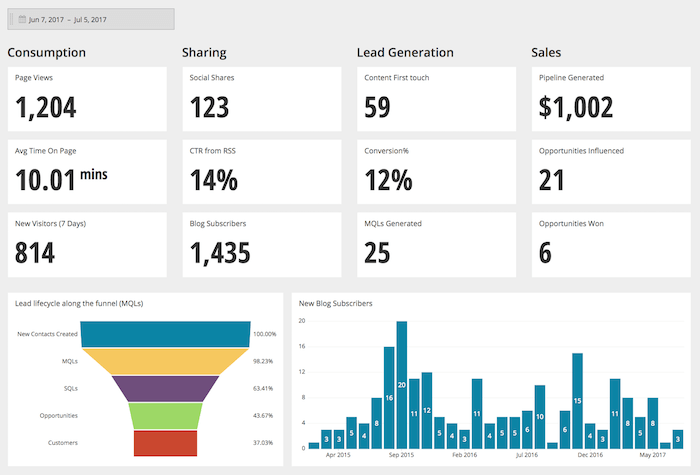Content marketing is a strategic marketing approach of creating and sharing content from blog posts to white papers to infographics as a means to generate awareness and education for a targeted audience. If successful, content marketing delivers relevant and valuable content to its audience to attract and retain their target audience to ultimately drive a return on investment (ROI) as marketing leads and customers.
With that, determining the success of content marketing initiatives starts with defining goals in terms of metric measurement. In this tutorial, we’ll explain the high-level content marketing metrics to track.
Content Marketing Metrics to Track
Taking a page from Jay Baer’s book, there are four buckets of content marketing metrics to track: consumption, sharing, lead generation and sales. These metrics can be shown on a dashboard like this one below:

These buckets of content marketing metrics can then be broken down in granularity:
Consumption
Pageviews
In general, pageviews report the number of pages a unique visitor viewed on your website. This is a good measurement of site popularity and indicates whether the content is resonating with your audience.
Average Time on Page
Similarly, the average time on page measures the amount of time a unique visitor spends on your website. This is a great indicator of content relevancy and user engagement.
New Visitors
Content is only useful if it’s able to reach its target audience. If no one is viewing your content, it isn’t achieving its intended impact. By measuring the number of unique new visitors to your website, you can determine if a piece of content is working or not.
Bounce Rate
A ‘bounce’ occurs when a new visitor hits your site and either exits or hits ‘Back’ without viewing any other page on your site. A high bounce rate percentage is a good indicator that the content you’re serving isn’t relevant to the audience and doesn’t keep them engaged.
Sharing
Social Shares
Measures of social engagement and shares such as retweets, likes, and comments are very potent indicators of content relevance and value. If a viewer liked a piece of content enough to share it or take an action with it, it’s an important metric to track.
Click-Through Rate
What’s even more telling about the relevance of content and behavior of a visitor can be measured through the social click-through rate (CTR) on a piece of content. CTR is the ratio between the number of clicks into content to the number of times that a link to that content was presented (such as through a content feed). A high CTR shows that the messaging was relevant and that the content piqued their interest.
Lead Generation
Content First Touch
First-touch refers to the first channel that a visitor interacted with before converting on your site. It is also known as first-click and first-interaction.
Traffic Sources
Users may come to your site through various means, such as social channels or direct campaigns. Tracking this metric allows you to know which channels have been the most effective in the past, providing learnings to carry on to future campaigns.
Conversion Percentage
The percentage at which viewers move from anonymous visitors to named contacts within your marketing automation platform. This can measure a few conversions: lead form fill, subscription, trial, demo, etc. based on your marketing definitions.
Marketing Qualified Leads Generated
For any marketing activity, the ROI can always be attributed to the number of leads the specific activity generated. This is no different for content marketing. Content marketing activities like blog posts, white papers, social engagement, etc. all lead to the marketing qualified lead (MQL) conversion flow, so this is an important metric to track. A qualified lead is one that has been identified as having a good probability of becoming a paid user.
Sales
Pipeline Influenced
Content marketing can be attributed back to the dollar amount of pipeline it influenced. Whether on a first-touch , last-touch or multi-touch attribution model, an important content marketing metric is measuring its influence in pipeline generation.
Opportunities Influenced
One step further down the sales funnel is converting sales pipeline into sales opportunities. Similarly, content marketing should be measured on its ability to influence this stage in the sales funnel.
Opportunities Won
Lastly, the ultimate metric for proving content marketing ROI is measuring the opportunities won. A well-executed strategy should provide relevant and valuable content to a highly targeted audience that pushes them along the marketing and sales funnel to the ultimate conversion.
Conclusion
While content marketing is still evolving as a discipline within the marketing machine, it’s important to track metrics to prove its effectiveness and influence on the overall business.